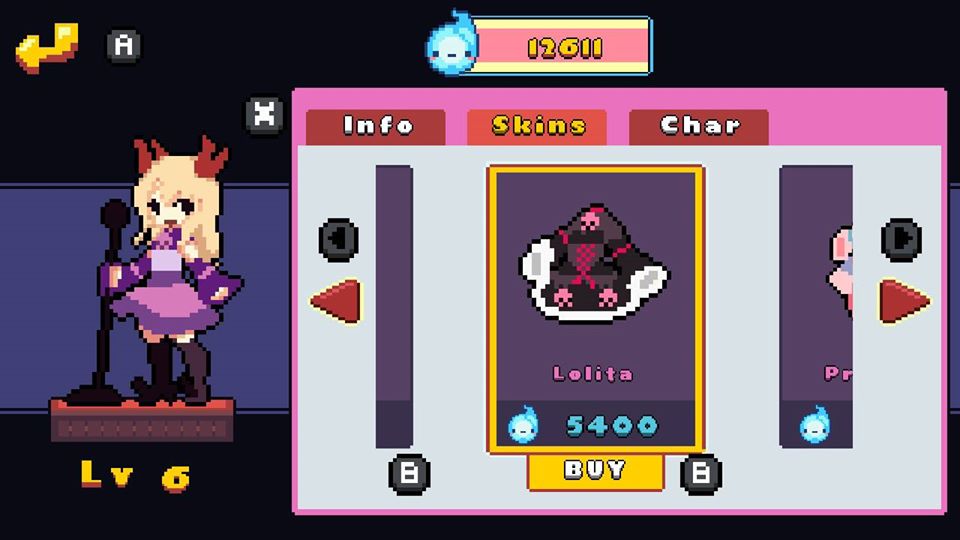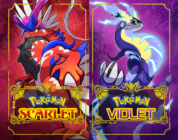Kawaii Deathu Desu reflects the Japanese idol culture that it attempts to parody; the game is bland, unimaginative, only slightly self-aware, and yet pretty and strangely addictive. However, these are largely things to mock, not to emulate. Although the attempt at satire is apparent and some of the visuals are lovely, Kawaii Deathu Desu is dragged down by its uninspired controls and a system that is far more dependent upon button mashing and grinding than skill or strategy.
The Premise
In Kawaii Deathu Desu, you play as idols who are monsters in disguise. The first character you can control is a girlish blonde in pigtails who, when she attacks, shows her true nature as a grim reaper. “Idols,” if you were unaware, are young, attractive, socially proficient, and usually female performers and models who are more or less owned by their talent agencies. Those agencies, in turn, use these girls to cultivate fanatical fanbases in order to sell merchandise. The problem with fanatical fans is that they sometimes harass the object of their devotion. Don’t get me wrong, idols are often treated as objects by their agencies, not people, and are set up to receive an unhealthy amount of manufactured attention in the name of profit.
In Kawaii Deathu Desu, however, the idols you play as seem to have lost their security detail. Right from the get-go, fans start rushing you from both sides of the stage that you are performing on. Luckily for you, according to the game’s website, you are trying to kill your fans. On top of that, you must harvest their souls for some contrived reason that is never mentioned in-game. The characters’ monstrous side has more than enough muscle to tear them apart or rather cut them apart. For most attacks, each fan/enemy splits down the middle no matter how you kill them. Cut them with a scythe? Split down the middle. Punch them in the ‘nads? Split down the middle. Tear them limb from limb? Split down the middle. Regardless, you must defend yourself until you have killed every one of them and survived your own concert.
The Controls
Right off the bat, the menu controls are counterintuitive and hard to read. Also, what sort of twisted individual assigns the “Confirm” selection to B and the “Back” selection to A? In Kawaii’s favor, however, the gameplay controls are easy to learn. You only press two buttons: the left bumper to attack left and the right bumper to attack right. When your special gauge has filled, you can press those buttons simultaneously to activate your character’s superpower, such as summoning a giant scythe or shooting little hearts to impale the oncoming hordes. Because of this simplicity, though, the controls and the gameplay itself are pathetic.
For one, you cannot move of your own volition. The best you get is a little shuffle in whichever direction you are attacking. This does not buy you much time to either escape the enemies on one side or close the distance with those approaching from the other. Enemies can thus swiftly swarm and box you in. At that point, the only (and I mean ONLY) thing that you can do is alternate smashing your left and right index fingers against the bumpers and hope that you can survive long enough for your special to activate or the level the end.
Just as an experiment, I decided to look away from the screen while furiously button mashing. While urging my hands not to seize up, I heard my super activate and then looked back when I heard the childish giggle that marked the end of the stage. Lo and behold, I had only taken two, maybe three hits. The fact is, if I did not need both hands to play, I could just breeze through each stage while doing something more interesting like scrubbing the floor.
The thing is, if your character is not a high enough level, even Matrix-esque reflexes will not save you and I doubt that the Switch could even register such swift inputs.
Stats and “Strategy”
Pippin Games advertises that each character encourages different strategies and play styles, however, that is patently false. Yes, each character has different stat growths, but those stats only change what difficulty you can play at. The stats are Life, Kick (which actually means “knockback” since few characters are even capable of kicking), Damage, Block (a.k.a. “Defense” because there is no actual “blocking” mechanic), and Magic, which is how quickly your special gauge fills. For example, the first character’s defense and knockback stats are fairly low but she has a higher attack and her special fills faster. The next character, by contrast, has lots of life and defense, but not as much magic. However, stat differentiation really means nothing in practice.
It all boils down to how quickly you can kill your enemies. If you cannot kill them fast enough, they hurt you. While your defense helps mitigate the damage some, you cannot complete a stage by tanking. Furthermore, in other game modes, your score is dependent upon how much damage you take or how frequently. Thus it is always better to just use someone who can kill everyone before they touch you. You can only do that, however, if you have leveled up your character sufficiently. Otherwise, it takes too many hits to kill a single enemy and you will become overwhelmed in the crush of bodies. More advanced enemies can jump back or to the other side of the screen, but it makes little difference. Like moths to a flame, they get sucked into the button-mashing murder machine eventually.
The Grind
In turn, leveling up your character requires spending money in the form of souls, which you collect by killing off your fanbase. Yet, unlocking additional characters likewise requires obscene amounts of souls. Furthermore, every unlocked character starts at level one, meaning that they are useless for higher difficulty stages. Thus the players have to make a choice: buy a character and grind even more souls to level them up to be comparable to what they already have or just level up the character they have been using and move on with the game. It’s like the leveling in Pokémon but worse.

5,400 souls… That’s worth four or five runs through an intermediate stage for a cosmetic. Costs more than your early level-ups.
Considering the complete lack of nuance or strategy in Kawaii, I had absolutely no desire to grind through the same twelve stages over and over again in order to effectively just buy a new skin. Heck, you can’t even advance to the next stage before beating the current one at least two or four times on the normal mode. That in itself was repetitive since nothing in the game allows for experimentation or different play styles. Even the achievements have no use. They don’t grant bonus souls or unlock outfits or art or anything. They are simply boxes to be checked off. Thanks, but I can accomplish that while doing my laundry. At least by the end I have the reward of clean clothes and a sense that I have not entirely wasted my time.
Then again, I went to bed afterward wondering how long it would take to get the next character because I wanted to see what would happen. “Holy crap,” I realized, “I might be mildly addicted.” So Kawaii Deathu Desu has at least that going for it. I even found myself turning it back on after I had showered and brushed my teeth. That being said, many people have a similar reaction to heroin.
Doesn’t make either experience good.

24,000 souls to unlock the last character, when you get about 1,500 for finishing the highest stages. Why would I do this same exact thing 16 times?
The One Thing They Did Well
Kawaii Deathu Desu may not be a good game by any means but it is a great portfolio piece for whoever did the character design and artwork. While the character art is not terribly original, it is attractive. During loading screens, you can see each unlocked idol in one of four outfits that you can buy for them. This screen shows both the pixel art sprite, which is pretty enough for the resolution and an anime-styled illustration of said character and outfit. Frankly, waiting for these loading screen illustrations was often the highlight of any stage. In order to acquire the various outfits, though, you must pay with souls. Again, this means more grinding. Bravo to whoever made these various outfits and illustrations but Pippin Games would have done well to put more time into the mechanics than into the fashion.
What The Developers Could Have Done
The thing is, Kawaii Deathu Desu had plenty of potential to be more. Pippin Games could have added a rhythm element, for one. You are a performer, after all, and each stage has a different song playing. Maybe you could have earned bonus souls for striking someone on the downbeat of the soundtrack. Granted, that might have required making the soundtrack more interesting than elevator music in a Chuck E. Cheese’s…
Alright, maybe they could have included more of a skill element without changing the gameplay too much! I noticed early on that, when you kill your fans, souls rise out of them with little faces drawn on. Some have Xs over their eyes and some looked happy. I thought that this was maybe according to how close they were when I killed them or how accurately I struck. Nope. Not the case. I could kill people with my super as they entered the screen and still get those happy souls.
The game is supposed to be ironic, though, right? Well, maybe. Kawaii Deathu Desu does not commit to the irony in any significant way. Idols are usually portrayed as cute, innocent, and vulnerable, yet here we are killing people in droves. Pippin could have made the backdrops super cutesy and the music metal as hell or the backdrops more interesting while making the fighting and music cutesy. They kind of went for that second one, but there is really not much dichotomy to highlight any irony or humor.
Then how about Kawaii Deathu Desu as a social critique? As of now, it makes fun of the toxic, obsessive, self-destructive fan community that idol culture encourages. Although Kawaii shows the various supernatural idols inundated with rabid fans and exploiting them, the developers could have struck at the heart of what makes idol culture so dangerous by having the characters kill their horrific managers and agents like maybe at the end of the last stage the idol could manage to break free of their indentured servitude. All the developers had to do was add another set of skins for greedy men in business suits that you could eviscerate. Pippin Games would not have even needed to create a boss battle or otherwise change the simplistic mechanics to do so.
So many missed opportunities…
In Short…
Unfortunately, Kawaii Dethu Desu, despite its lovely visuals, is comparable to the free, mindless games that you might find on that virus-ridden website Addicting Games. If you do play Kawaii on the Switch, though, be ready to wear out those bumper buttons. Also, don’t play it with someone else in the room. The endless clicking is sure to drive them up the wall and you do not need that conflict during the quarantine .








